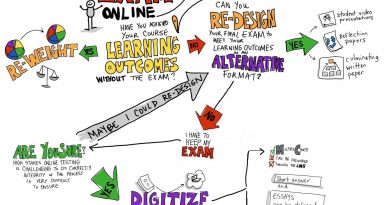Balancing Flexibility and Rigor to Advance Equity in Course Design
This is part 4 of a series exploring how many of our assumptions about learning were challenged, and in many cases, transformed by those challenges during the pandemic. This post addresses the purported dichotomy between academic rigor and flexibility and the important role that equity plays in this debate. To read other articles in the series, start with the introduction: Have We Been Transformed & How
As we responded to the pandemic through modified or sometimes radically restructured course design and assessment, there were concerns about whether the need for flexibility would compromise rigor, however each instructor defined the term. This tension sparked many deep and reflective conversations among instructors and students about what rigor means, and whether flexibility was “coddling.” Throughout this time, instructors have been encouraged to incorporate more flexibility than ever before into their courses as students grappled with course modalities, health concerns, racism, political unrest, and myriad other challenges. Many instructors wondered: Will increasing flexibility in my course compromise its rigor? At the crux of this perceived dichotomy between flexibility and rigor lies the issue of equity. The pandemic revealed and exacerbated inequities among students, and we were forced to think about what rigor really means in the context of equity. While questions about whether rigor and flexibility could co-exist gained attention due to the pandemic, understanding this relationship, and specifically how misconceptions about rigor can increase inequity, is fundamental to creating a more equitable higher education system.
Unexamined and loosely formed conceptions of rigor can lead to gatekeeping and elitism and can create inequities. Adhering to the word’s etymological roots (rigorem, Latin for stiffness) and discipline-specific constructs (e.g., rigorous scientific experimental design) can cause us to think of rigor as adhering absolutely to certain constraints (Campbell et al., 2018; Draeger et al., 2013; Nelson 2010). These definitions of rigor hide untested assumptions that a rigorous course uses objective and fair measures of each student’s learning (Henning & Lundquist 2018), sometimes for purposes of “weeding out” students perceived as weaker. An assumption commonly made by instructors is that graded assessments are an effective way to ensure rigor, i.e., students’ successful completion of an assessment indicates they have achieved the standards and outcomes associated with the course. Going further, it is often assumed that all students must be assessed in exactly the same way to maintain validity and reliability of the assessment. These assumptions are some of many that go untested or unchallenged when we cloak them under misconceptions of rigor.
One problem with these unexamined assumptions about rigor is that they create inequities by privileging students with deeper cultural capital, that is, students who have accumulated particular knowledge and skills that make them more competent in the academic sphere. Consider the example of assignment deadlines. Students who face certain challenges may not be able to devote as much time to their studies as their peers; this disadvantage becomes compounded if they lack the knowledge that they can request extensions on assignments. Similarly, high stakes exams with difficult multiple-choice questions favor students who have accumulated test-taking strategies and may not necessarily accurately assess knowledge of the content. Though the intent may be to maintain high standards, these notions of rigor produce inequities that disproportionately and negatively impact minoritized and marginalized students.
Does this mean instructors should lower their standards to achieve equity? Absolutely not—indeed, productive use of rigor can improve learning outcomes for all students while simultaneously reducing inequities by specifically leveling the playing field for students of marginalized identities (Braxton & Francis, 2018). In this framing, rigor can be defined as “deep, inquiry‐based and equity‐based learning that sufficiently challenges and encourages all students to achieve their full potential, including both academic and broader development” (Campell et al., 2018). Notions of rigor that center on a heavy workload or arbitrary complexity or difficulty would be better replaced with a framework that promotes deep, meaningful learning in courses to provide the opportunity and support for all students to meet high standards. While instructors may define rigor in different ways, what matters is taking an informed and equitable approach when applying it to one’s teaching.
Flexible approaches to teaching preserve this notion of rigor by reducing barriers so that all learners can engage in deep, meaningful learning. Flexibility can provide multiple avenues for students to navigate content, demonstrate their learning, and more deeply and meaningfully connect with course material (UDL; CAST, 2018). For example, imagine that an instructor is concerned that a single form of assessment might advantage some students over others. They decide to incorporate choice in a short answer quiz by allowing students to pick a subset of questions to answer from a larger pool (e.g., “Answer two out of these three prompts”). Some might argue that allowing choice decreases the assessment’s reliability and validity (Piontek, 2008), and thus its rigor, as a common assumption is that in order for an assessment to be rigorous and equitable, it must be identical for all students. However, given the fact that any assessment can only contain a limited number of prompts, there is some arbitrariness in which few prompts an instructor includes. If instructors make that choice for students, they inadvertently advantage the students who would have chosen to answer those questions, while disadvantaging those who wouldn’t. As long as all question options allow an instructor to say with confidence that successful student performance indicates they have met the criteria for learning, giving students a choice can be very effective.
Adding flexibility by offering students some choice of assessments or within assessments can increase equity and give a more accurate picture of their learning. Moreover, the act of choice, along with the selection of a format most appealing to them, can enhance their intrinsic motivation (Ryan & Deci, 2000). There are a variety of ways that instructors can incorporate choice in assessments: students could choose among different formats (writing a blog post, creating a video, or building a model), or students could have the option to resubmit their work on an assessment once they’ve received feedback (either on early drafts to improve the final product, or on a final assessment). Choice of project or assignment topic can appeal to a student’s values, as this allows them to make a more personal connection with the course content. Finally, giving students choice in the platform or media they use to demonstrate their learning can account for various constraints that some students experience.
Though at first glance, course flexibility and rigor may seem at odds with one another, these two concepts can—and should—coexist for the sake of equity. We encourage instructors to examine their underlying assumptions around academic rigor and to redefine and practice rigor in terms that are compatible with flexible teaching and equitable learning.
In what ways are you incorporating flexibility into your courses, and how are you able to maintain high standards while doing so? Share your stories by emailing us at celt@tufts.edu.
References
Braxton, J. M., & Francis, C. H. (2018). The Influence of Academic Rigor on Factors Related to College Student Persistence. New Directions for Higher Education, 2018(181), 73–87. https://doi.org/10.1002/he.20272
Campbell, C. M., Dortch, D., & Burt, B. A. (2018). Reframing Rigor: A Modern Look at Challenge and Support in Higher Education. New Directions for Higher Education, 2018(181), 11–23. https://doi.org/10.1002/he.20267
CAST (2018). Universal Design for Learning Guidelines version 2.2. Retrieved on Apr 21, 2021 from http://udlguidelines.cast.org
Draeger, J., del Prado Hill, P., Hunter, L. R., & Mahler, R. (2013). The Anatomy of Academic Rigor: The Story of One Institutional Journey. Innovative Higher Education, 38(4), 267–279. https://doi.org/10.1007/s10755-012-9246-8
Henning, G. W., & Lundquist, A. E. (2018, August). Moving towards socially just assessment (Equity Response). Urbana, IL: University of Illinois and Indiana University, National Institute for Learning Outcomes Assessment (NILOA).
Nelson, C. E. (2010). 10: Dysfunctional Illusions of Rigor. To Improve the Academy, 28(1), 177–192. https://doi.org/10.1002/j.2334-4822.2010.tb00602.x
Piontek, M. E. (2008). Best practices for writing and grading exams. CRLT Occasional Paper, No. 24. Ann Arbor, MI: Center for Research on Learning and Teaching, University of Michigan.
Ryan, R. M., & Deci, E. L. (2000). Intrinsic and Extrinsic Motivations: Classic Definitions and New Directions. Contemporary Educational Psychology, 2




